DISCOVERY OF DINOSAURS
The discovery of dinosaurs must be seen in context of what was happening with the developing geological column.1. We have seen how various fossils were already being attributed to an origin by natural causes by the 18th century, perhaps the best example being Steno's Glossopetrae.
2. In 1676, Robert Plot described Scrotum Humanumin the "Natural History of Oxfordshire", which we now recognize as a distal end of a dinosaurian femur (thigh bone).
Although it was properly described as a thigh bone, it was erroneously thought to be from an elephant brought in by the Romans.
3. Georges Cuvier
In the 1780's a slab of chalk with giant jaws was discovered in a chalk quarry in the town of Maastrict in the Netherlands.
The town was sacked by Napoleon's army in 1795.
It was described by the great French comparative anatomist Georges Cuvier in 1808 as a giant extinct marine lizard. He named it the Mosasaurus (or Meuse lizard) from the Meuse River near the town of Maastricht. Cuvier was correct in his interpretation and this was no dinosaur.
Cuvier used the comparative method in which he compared the structure of the skeleton of the skull of the Mosasaurus with that of varanid lizards. Although there are differences between the two, he recognized that Mosasaurus was far more similar to a lizard than to anything else.
Cuvier also used the principle of the correlation of parts in which the form of one set of structures are shared between different species of organisms and the form of many other structures are similarly shared or correlated. So the closer, say, the skulls of two different lizard species are, the closer in form are the rest of the skeletons as well.
Most critically, Cuvier recognized the importance of extinctions. Cuvier recognized that extinctions are a fundamental feature of the geological record. He attributed this to repeated creation and extinction events. He was what we would call a "catastrophist".
Cuvier also described vertebrae from France which he described as a giant extinct crocodile, although we think now they were dinosaurian.
In 1806 they mentioned a giant leg bone they found near Billings, Montana that was certainly a dinosaur. Unfortunately their search for living mastodons was unsuccessful.In the 1820ís Gideon and Mary Ann Mantell discovered fragmentary remains of a very large animal that was eventually named by Mantell Iguanodon. Mantell reasoned that it might be a giant version of an Iguana, since the teeth he found bear a slight resemblance to the teeth of that kind of extant lizard.
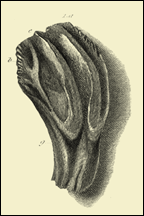
Drawing of an isolated drawing of a single tooth of Iguanodon (from Mantell, 1825). |
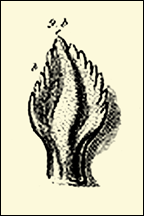
Drawing of an isolated drawing of a single tooth of a modern Iguana (from Mantell, 1825). |
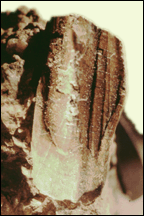
Example of a single British Museum specimen of an Iguanodon tooth. |
In 1840 the Mantells found somewhat more complete remains of Iguanodon called the Maidstone Iguanodon that permitted a reconstruction by Gideon. The Mantells also found a bone he assumed was a horn, that later turned out to be the thumb.
Turns out that William Smith had found bit of Iguanodon as well.In 1824 William Buckland found remains of what he named Megalosaurus.
Cuvier thought it might be 40 ft long
Partial skeleton allowed reconstruction
1833 - HylaeosaurusIn 1836 Edward Hitchcock reported on the discovery of what he believed to be the tracks of giant birds.
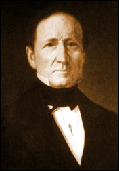 |
|
|
|
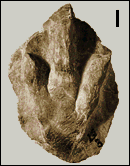 |
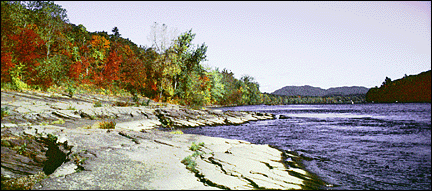
The Footprint Preserve in Holyoke. Massachusetts on the Connecticut River. The tilted layers of rock on the shores of the river have many hundreds of dinosaur footprints. These layers were quarried as flagstones and in the process the first dinosaur footprints were discovered.
| Hitchcock got into a dispute with a former friend, a Dr. James Deane, about who really found the first dinosaur tracks and realized their significance. Hitchcock tried to diffuse the problem by recounting a story about the young Pliny Moody. Moody was a farmer in South Hadley, Massachusetts around the turn of the 18th century, who in 1802 or 1803 plowed up some slabs of dinosaur tracks in one of his fields. One particular slab (at right) stood for many years as a doorstop in the Moody home where it was referred to as the track of "Noah's Raven" | 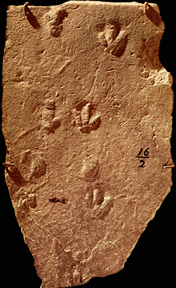
Slab of dinosaur tracks called "Noah's Raven" and now recognized as Anomoepus scambus, the footprints of a small ornithischian dinosaur. |
By 1865, the year of his death, Hitchcock had named hundreds of species of footprints. Based on their resemblance to the tracks of birds he remained true to his idea that most of them were made by birds. However he also recognized that some of them had, in addition to bird-like feet, impressions of five-fingered hands, and that they could not have been made by birds but rather by some bird-like reptile or perhaps some kind of marsupial (Kangaroos have feet that look three toed, although they are not).
Ironically, fragmentary bones of a real dinosaur from near by had been described 16 years earlier (Ellworth, 1820), but they were thought to be human.
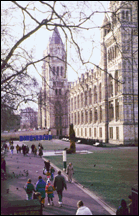
British Museum of Natural History, London |
Richard Owen (right) was a comparative anatomist
at the British Museum (left) of Natural History in London who lived from
1804 - 1892 and became justifiably famous as the intellectual successor
to Cuvier. Both Mantell and Buckland communicated with Owen and Owen developed
a great interest in their discoveries.
In 1842, Owen put Iguanodon, Megalosaurus, and Hylaeosaurus in a group he named the Dinosauria or "terrible lizards". Owen noted that they had a mixture of reptilian and mammalian (or bird-like) features. He pointed out that these were more advanced than modern reptiles and thus progressionist (evolutionist) theories must be wrong, because it would mean that modern reptiles were degenerate. |
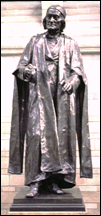
Bronze statue of Sir Richard Owen at the British Museum |
In Owen's words, "The combination of such characters, some, as the sacral ones, altogether peculiar among Reptiles, others borrowed, as it were, from groups now distinct from each other, and all manifested by creatures far surpassing in size the largest living reptiles, will, it is presumed be deemed sufficient ground for establishing a distinct tribe or sub-order of Saurian Reptiles, for which I would propose the name of Dinosauria. Of this tribe the principle and best established general are the Megalosaurus, the Hylaeosaurus, and the IguanodonÖ."
Owen was in communication with Hitchcock and though that the Massachusetts tracks might be bipedal saurians or marsupialoid reptiles. Owen coined the term avian to recognize this similarity.
Owen was a remarkably popular speaker and crowds of hundreds would listen to him lecture on ancient life forms. He worked with the artist Waterhouse Hawkins on models and drawings that could help bring the Dinosauria to life. Based on instructions from Owen, Hawkins reconstructed Iguanodon and Megalosaurus as huge hulking quadrupedal reptiles with elephant-like proportions.
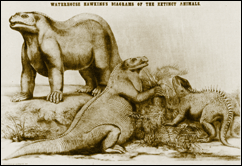 Reconstruction of Iguanodon by Waterhouse Hawkins. |
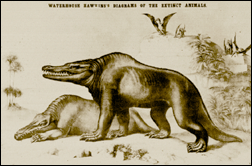 Reconstruction of Megalosaurus by Waterhouse Hawkins. |
The Crystal Palace was a magnificent glass structure built to celebrate the first of the world's fairs, the great exhibition of 1851 in Hyde Park, London. Later it was moved to Syndenham on the outskirts. Owen and Hawkins were commissioned in 1852 to produce a life-sized outdoor diorama of prehistoric life for the rebuilt Crystal Palace that were to include cement and tile models of Iguanodon and Megalosaurus. At the inauguration of the new exhibit, a dinner was held inside the model Iguanodon with Owen as the honored guest. Dinosaurs were a BIG DEAL!
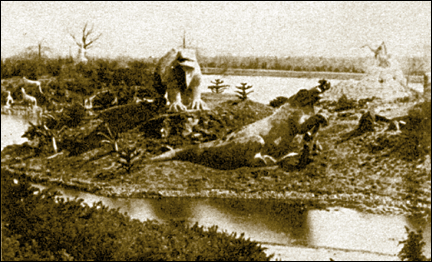
The models of Igaunodon(looking right) and Megalosaurus(looking forward as they appeared at the Crystal Palace in the early 1860's (from Ryder, 1986).
But the concept of what the Dinosauria were like was about to be overturned.
Joseph Leidy
In 1858 a partial skeleton was discovered by William Parker Foulke in a marl pit in Haddonfield, New Jersey. It came to the attention of Joseph Leidy at the Academy of Natural Science in Philadelphia. Leidy described the skeleton, naming it Hadrosaurus foulki, or "Foulke's heavy lizard".
Leidy showed that Hadrosaurus was clearly similar to Iguanodon, but because it had such short arms it almost certainly had to be bipedal.
This had the immediate effect of revolutionizing the reconstructions of dinosaurs.
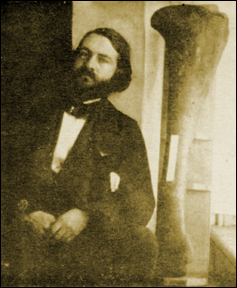 Joseph Leidy ca. 1860 with the tibia of Hadrosaurus foulki (from Ryder, 1986). |
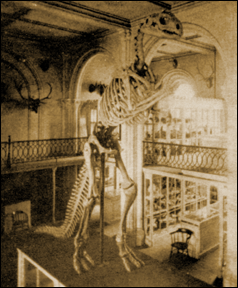 Hadrosaurus reconstruction as a free standing mount at the Smithsonian Institution in Washington (Photograph by Smillie, ca. 1878, from Ryder, 1986) |
| Now dinosaurs would be reconstructed as active, fairly graceful animals.
On the right is a painting by Waterhouse Hawkins showing Iguanodon as well
as several other dinosaurs and aquatic reptiles (not dinosaurs).
The dinosaur being bitten on the neck, is Iguanodon, the one doing the biting is Megalosaurus, on the right several Hadrosaurus leave with worried looks. |
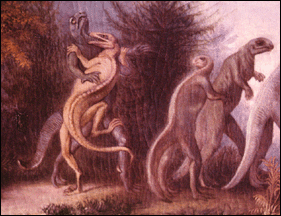 |
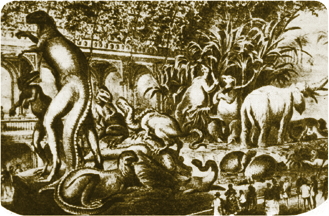
Hawkin's Museum in Central Park as he imagined it would look when finished. |
In 1868, Waterhouse Hawkins was commissioned to make a display of dinosaur reconstructions in Central Park. However, Hawkins ran afoul of "Boss Tweed" and the latter's gang, smashed the models to bits and threw them into the lake in the Park. All that remains are drawings - but oh how they differed from Hawkins older models! |
| In 1878 large numbers of completely articulated Iguanodon skeletons
were discovered in a coal mine in Bernissart, Belgium.
These proved to be the most complete dinosaurian remains found to that time. They were described in detail by Louis Dollo in 1882 and it finally became clear where the spike-like object went - on the hand. On the right is a photo of one of the Bernissart skeletons being mounted . |
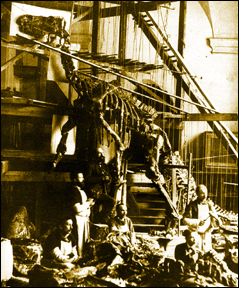 |
Cope and Marsh
 |
During the 1860's Edward
Drinker Cope (1840-1897), student of Joseph Leidy, described various
dinosaurs from the Cretaceous of New Jersey and adjacent states.
In 1864 Edward Hitchcock dies and three years afterward in 1867, Edward Drinker Cope announces that Hitchcock's "stony bird tracks" were most likely made by dinosaurs. |
| Othniel
Charles Marsh (1831-1899), born a modest farm boy but nephew of the
wealthy banker and philanthropist, George Peabody, became a professor at
Yale University with a very strong interest in prehistoric life.
During the 1860s Marsh and Cope had an amicable relationship, working mostly on vertebrates from Eastern North America. In about 1877 Arthur Lakes and O. W. Lucas discovered dinosaurs in the Southwest United states. They began to ship them to Cope and Marsh, A harsh rivalry between Marsh and Cope soon broke out, however, that lasted until their deaths. Marsh hired Lakes; Cope hired Lucas, and the war was on. See Colbert (1984) for a detailed account of their rilvalry. |
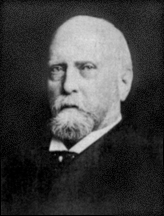
O. C. Marsh |
References:
Colbert, E. H., 1984, The Great Dinosaur Hunters and their Discoveries, New York, Dover, 283 p. [originally published as "Men and Dinosaurs" by E. P. Dutton & Company, New York, in 1968].Cope, E. D., 1867, [An account of the extinct reptiles which approached the birds]. Academy of Natural Sciences of Philadelphia, Proceedings, v. 19, p. 234-235.
Mantell, G., 1825, Notice on the Iguanodon, a newly discovered fossil reptile, from the sandstone of Tilgate Forest, in Sussex. Philosophical Transactions of the Royal Society of London, v. 115, p. 179-186.
Go to Lecture 4
Return to the Dinosaurs 2001 home page
send comments and questions to : polsen@ldeo.columbia.edu
